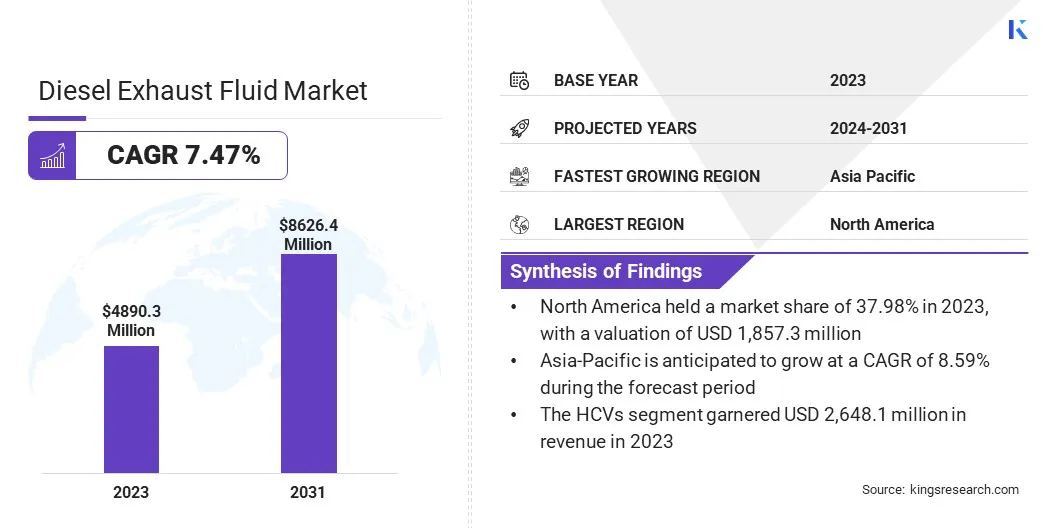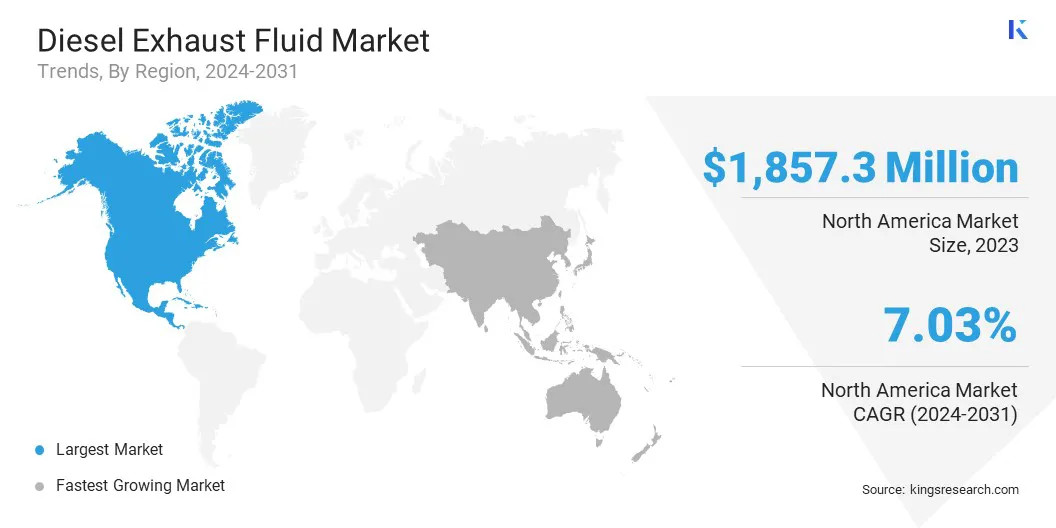Diesel Exhaust Fluid Market Size
The global Diesel Exhaust Fluid Market size was valued at USD 4,890.3 million in 2023 and is projected to grow from USD 5,208.8 million in 2024 to USD 8,626.4 million by 2031, exhibiting a CAGR of 7.47% during the forecast period. The market is expanding rapidly due to the global shift toward cleaner diesel engine emissions.
Rising environmental awareness and government mandates for emission reduction are boosting the demand for DEF. Innovations in DEF production and the expansion of distribution networks are further contributing to market growth by enhancing accessibility and ensuring compliance with environmental standards.
In the scope of work, the report includes solutions offered by companies such as Mitsui Chemicals Inc, BP p.l.c, AirNox, TotalEnergies, BASF SE, Cummins Inc, GreenChem Petroleum, Inc., Power Blue International, Royal Dutch Shell PLC, Adeco doo, and others.
The diesel exhaust fluid (DEF) market is experiencing robust growth, propelled by increasing environmental regulations and the rising adoption of diesel vehicles in the commercial sector. DEF, also known as AdBlue, is essential for reducing harmful nitrogen oxide emissions in diesel engines, aligning with stringent emission standards like Euro 6.
Governments worldwide are implementing stricter pollution norms, with notable emphasis in Europe, California, and emerging markets in Asia and Latin America.
- For instance, the International Council on Clean Transportation estimates that between 2020 and 2025, over 80 million heavy and light commercial diesel vehicles will need to be upgraded to newer models equipped with AdBlue technology. This upgrade is necessary to meet increasingly strict emission standards in major global vehicle markets.
This regulatory push, combined with the growing awareness of the health risks associated with vehicle emissions, is significantly boosting the demand for DEF.
Diesel exhaust fluid (DEF) is a critical component used in diesel engines that are equipped with selective catalytic reduction (SCR) systems to reduce nitrogen oxide (NOx) emissions. DEF is a clear, non-hazardous liquid composed of urea and deionized water. When injected into the exhaust stream, it reacts with NOx in the SCR catalyst to convert it into nitrogen and water vapor.
This chemical reaction helps diesel engines meet stringent emission regulations and improve air quality. By effectively lowering NOx emissions, DEF plays a crucial role in reducing the environmental impact of diesel-powered vehicles and machinery.

Analyst’s Review
The global tightening of emission regulations globally is boosting the growth of the market. Governments are intensifying their efforts to reduce vehicular emissions and enhance air quality by enforcing strict norms such as Euro 6 in Europe and Bharat Stage VI in India.
These regulations mandate the use of selective catalytic reduction (SCR) technology, which requires DEF to convert nitrogen oxides into harmless substances. This regulatory push has substantially increased the demand for DEF in the automotive sector.
- In the U.S., the implementation of new emission standards has led to a 95% reduction in nitrogen oxide emissions from long-haul trucks and buses, thereby establishing the country as a major market for DEF.
Key players may capitalize on tightening emission regulations by investing heavily in advanced DEF technologies and expanding production capacity. Collaborating with automotive manufacturers and enhancing distribution networks are anticipated to address the growing demand effectively. Additionally, engaging in regulatory advocacy and innovation is projected to position them favorably in the expanding DEF market.
Diesel Exhaust Fluid Market Growth Factors
Governments worldwide are implementing stringent emission regulations to reduce environmental pollution caused by diesel engines. These regulations mandate the use of technologies such as selective catalytic reduction (SCR), which requires diesel exhaust fluid (DEF) to function effectively.
SCR technology reduces nitrogen oxide emissions from diesel engines by injecting DEF into the exhaust stream, decompossing harmful pollutants into harmless nitrogen and water.
The demand for DEF is rising as both vehicle manufacturers and fleet operators strive to comply with these stringent regulations. Ensuring the availability and use of DEF is crucial for reducing the environmental impact of diesel emissions and achieving cleaner air standards, which is propelling the diesel exhaust fluid market growth.
Stringent global emission regulations are leading to increased demand for diesel exhaust fluid. However, several challenges are hindering market growth. Limited consumer awareness of DEF and its operational benefits is impacting adoption rates. Issues related to the consistent availability and ongoing maintenance of DEF throughout a vehicle’s lifespan are creating considerable obstacles to market development.
Additionally, high production and transportation costs are increasing DEF’s price, which deters potential buyers and constrains market expansion. Key players are actively addressing these challenges by launching educational campaigns to improve consumer understanding of DEF and its advantages. They are further streamlining production and distribution processes to lower costs and enhance accessibility.
By investing heavily in infrastructure improvements and collaborating with automotive manufacturers, these strategies are aimed at overcoming these challenges and fostering market growth.
Diesel Exhaust Fluid Market Trends
Stricter emission regulations and rising environmental consciousness among consumers are prompting automakers to manufacture vehicles with lower carbon footprints.
This trend is significantly boosting the popularity of diesel engines, particularly in the commercial vehicle sector, where diesel-powered trucks, buses, and other goods carriers are highly favored for their superior fuel efficiency and load-carrying capabilities compared to petrol variants.
This is resulting in the surging demand for diesel exhaust fluid (DEF) to ensure that these vehicles comply with emission standards. This growing adoption of diesel engines is propelling the growth of the DEF market, as DEF becomes essential for maintaining environmentally friendly and efficient diesel vehicles.
The rising levels of vehicle pollution globally pose a significant environmental challenge, particularly due to diesel vehicles that emit toxic nitrogen oxide. This situation, however, presents a substantial opportunity for the progress of the diesel exhaust fluid market. DEF, or AdBlue, is added to selective catalytic reduction systems in diesel vehicles to convert nitrogen oxide emissions into harmless nitrogen and water vapor.
As more countries implement stringent emission regulations to curb air pollution, the demand for AdBlue is rising. With the widespread adoption of Euro 6 and equivalent standards, especially in Europe and California, and the anticipated tightening of pollution norms in Asia and Latin America, the demand for DEF is expected to increase.
- In November 2022, OMV Petrom announced the start of AdBlue production, also known as diesel exhaust fluid, in Romania. This followed an investment of EUR 800,000 (approximately USD 834,000) in a new production facility located south of Bucharest. In the initial phase, AdBlue will be available at OMV and Petrom filling stations, with plans to expand sales to other networks beginning of 2023.
Segmentation Analysis
The global market is segmented based on vehicle types, end market, and geography.
By Vehicle Types
Based on vehicle types, the market is categorized into passenger cars, LCVs, and HCVs. The HCVs segment garnered the highest revenue of USD 2,648.1 million in 2023. HCVs, including trucks, buses, and freight carriers, are significant sources of diesel emissions and thus serve as a primary focus for technologies aimed at emission reduction.
Due to stringent emission regulations requiring the use of SCR systems to meet environmental standards, there is strong demand for DEF. HCV operators are increasingly adopting DEF to comply with regulations such as Euro 6 and Bharat Stage VI, which mandate substantial reductions in nitrogen oxide emissions. This increased focus on cleaner technologies for HCVs boosts the demand for DEF, as fleets transition to compliant systems and seek efficient solutions to manage emissions.
By End Market
Based on end market, the market is categorized into OEM and aftermarket. The OEM segment captured the largest diesel exhaust fluid market share of 56.78% in 2023. OEMs are pivotal in integrating DEF systems into new diesel vehicles to meet stringent emission regulations.
As regulatory standards such as Euro 6 and Bharat Stage VI become more stringent, OEMs are increasingly incorporating selective catalytic reduction (SCR) technology, which relies on DEF, into their vehicle designs. This integration ensures that new vehicles adhere to emission norms, thereby boosting the demand for DEF.
Moreover, OEMs' collaborations with DEF producers and their commitment to advanced emission control technologies are supporting segmental growth through enhanced vehicle offerings and regulatory compliance.
Diesel Exhaust Fluid Market Regional Analysis
Based on region, the global market is classified into North America, Europe, Asia-Pacific, MEA, and Latin America.

North America diesel exhaust fluid market share stood around 37.98% in 2023 in the global market, with a valuation of USD 1,857.3 million. Stringent environmental regulations imposed by the U.S. Environmental Protection Agency (EPA) and Environment Canada are leading to the widespread adoption of diesel exhaust fluid.
These regulations mandate the use of selective catalytic reduction (SCR) systems in diesel vehicles and equipment to meet Tier 3 and Tier 4 emission standards. Major automotive manufacturers such as Ford, GM, and Fiat Chrysler have integrated urea-based DEF injection systems into their diesel product lines to ensure regulatory compliance.
The presence of leading DEF producers such as Yara International, CF Industries, and BASF, combined with a robust retail distribution network, guarantees a stable supply and competitive pricing. This regulatory environment and established infrastructure are fostering regional market growth and reinforcing the widespread use of DEF across the region.
Asia-Pacific is anticipated to witness substantial growth at a CAGR of 8.59% over the forecast period. This growth is largely attributed to rapid industrialization and extensive infrastructure development, which have significantly increased the demand for diesel-powered commercial vehicles, construction equipment, and generators.
Fast-growing economies, including India, China, Indonesia, and Vietnam, are investing heavily in road and rail projects, special economic zones, and ports, highlighting the pressing need for diesel machinery and trucks.
- According to the International Trade Administration, China was the world's largest construction market in 2023. The country's 14th Five-Year Plan focused on developing new infrastructure, including transportation, energy, and water systems. The organization estimated an investment of USD 4.2 trillion in these new infrastructure developments between 2021 and 2025.
Furthermore, these countries are implementing stringent Euro emission standards for new diesel registrations to combat urban air pollution, leading to the widespread adoption of DEF technologies. As the establishment of bulk storage and retail DEF dispensing stations progresses, numerous Asian nations have achieved self-sufficiency in urea manufacturing, thereby enhancing supply security.
Additionally, Asia-Pacific's well-developed marine and land trade routes position the region as a significant importer and exporter of DEF, supporting global supply chains and contributing to regional market expansion.
Competitive Landscape
The global diesel exhaust fluid market report will provide valuable insight with an emphasis on the fragmented nature of the industry. Prominent players are focusing on several key business strategies such as partnerships, mergers and acquisitions, product innovations, and joint ventures to expand their product portfolio and increase their market shares across different regions.
Companies are implementing impactful strategic initiatives, such as expanding services, investing in research and development (R&D), establishing new service delivery centers, and optimizing their service delivery processes, which are likely to create new opportunities for market growth.
List of Key Companies in Diesel Exhaust Fluid Market
- Mitsui Chemicals Inc
- BP p.l.c
- AirNox
- TotalEnergies
- BASF SE
- Cummins Inc
- GreenChem Petroleum, Inc.
- Power Blue International
- Royal Dutch Shell PLC
- Adeco doo
Key Industry Development
- February 2024 (Product Launch): BPCL launched Kolkata's first mobile AdBlue dispenser. This battery-powered unit minimizes the need for commercial vehicle hubs and fuel stations to invest in permanent AdBlue filling stations. By improving the accessibility and convenience of diesel exhaust fluid, this innovation is expected to boost its adoption and foster market growth.
The global diesel exhaust fluid market is segmented as:
By Vehicle Types
By End Market
By Region
- North America
- Europe
- France
- U.K.
- Spain
- Germany
- Italy
- Russia
- Rest of Europe
- Asia-Pacific
- China
- Japan
- India
- South Korea
- Rest of Asia-Pacific
- Middle East & Africa
- GCC
- North Africa
- South Africa
- Rest of Middle East & Africa
- Latin America
- Brazil
- Argentina
- Rest of Latin America


